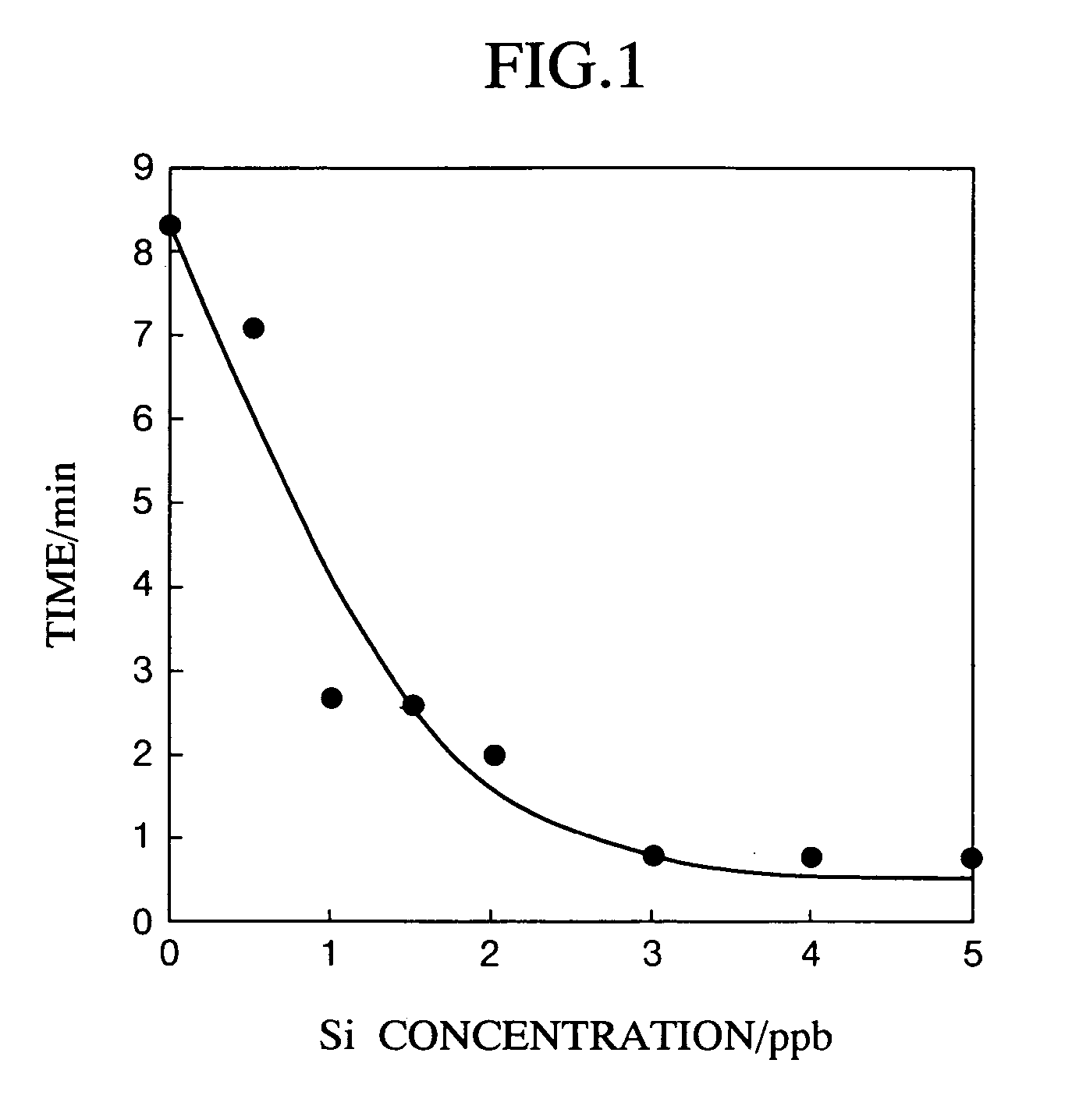Method and apparatus for measuring trace ingredients in water
a technology of trace ingredients and measuring methods, applied in biochemistry apparatus and processes, instruments, fluorescence/phosphorescence, etc., can solve the problems of inability to filter, high cost and equipment scale, and affecting the effect of living organisms, etc., to achieve high resolution, high accuracy, and high sensitivity
- Summary
- Abstract
- Description
- Claims
- Application Information
AI Technical Summary
Benefits of technology
Problems solved by technology
Method used
Image
Examples
example 1
[0094] Aqueous solution samples in an amount of 5 ml containing silica (sodium hexafluorosilicate: extra-high grade; Wako Pure Chemical Industries, Ltd.) at the concentrations shown in Table 1 were each put in a fluorescence detecting cell; 5.0 M sulfuric acid (for precision analysis; Kanto Kagaku Co.) in an amount of 70 μl (0.07 M) was added thereto and the resultant mixture was shaken; and then, 3.0×10−2 mol dm 3 ammonium molybdate (for precision analysis; Wako Pure Chemical Industries, Ltd.) in an amount of 300 μl (1.8×10−3 mol dm−3) was added thereto and the resultant mixture was shaken. Finally, 8.0×10−5 mol dm−3 Rhodamine B (Guaranteed Reagent Rhodamine B; Kanto Kagaku Co.) in an amount of 250 μl (4.0×10−6 mol dm−3) was added. The time was measured from the addition of Rhodamine B until a prescribed fluorescence intensity (450 in this example) was reached.
[0095] In all the examples including this one, ultrapure water was used for diluting the reagents. Measurement of fluoresc...
example 2
[0097] Measurements were carried out under quite the same conditions as Example 1, except that aqueous solution samples containing phosphorus (sodium dihydrogen phosphate: extra-high grade; Wako Pure Chemical Industries, Ltd.) at concentrations shown in Table 2 were used in place of the aqueous solution samples containing silica. The results are shown in Table 2 and FIG. 2.
TABLE 2P (ppb)TIME (min)06.3211.7820.95
[0098] The results shown in Table 2 and FIG. 2 indicate that the time required for the fluorescence of Rhodamine B to be attenuated to a prescribed intensity along with ion association with molybdophosphate ion depends upon the phosphorus concentration relative to trace phosphorus concentration equal to or lower than 2 ppb. This correlation between phosphorus concentration and time is applicable as a calibration curve for measuring the phosphorus concentration in a water sample for which the concentration is unknown.
example 3
[0099] Aqueous solution samples in an amount of 5 ml containing arsenic (disodium hydrogen arsenate: extra-high grade; Kanto Kagaku Co.) at the concentrations shown in Table 3 were each put in a fluorescence detecting cell; 4.0×10−2 mol dm−3 potassium iodate (extra-high grade; Wako Pure Chemical Industries, Ltd.) in an amount of 250 μl (2.0×10−3 M) was added thereto and the resultant mixture was shaken; then, 5M sulfuric acid (for precision analysis; Kanto Kagaku Co.) in an amount of 140 μl (0.14 M) was added thereto and the resultant mixture was shaken; and then, 2.5×10−2 mol dm−3 ammonium molybdate (for precision analysis; Wako Pure Chemical Industries, Ltd.) in an amount of 1,000 μl (5.0×10−3 M) was added thereto and the mixture was shaken. Finally, 2.0×10−4 mol dm−3 Rhodamine B (Guaranteed Reagent Rhodamine B; Kanto Kagaku Co.) in an amount of 100 μl (4.0×10−6 M) was added. The time required was measured from the addition of Rhodamine B until a prescribed fluorescence intensity...
PUM
| Property | Measurement | Unit |
|---|---|---|
| Fraction | aaaaa | aaaaa |
| Fraction | aaaaa | aaaaa |
| Fraction | aaaaa | aaaaa |
Abstract
Description
Claims
Application Information
 Login to View More
Login to View More - R&D
- Intellectual Property
- Life Sciences
- Materials
- Tech Scout
- Unparalleled Data Quality
- Higher Quality Content
- 60% Fewer Hallucinations
Browse by: Latest US Patents, China's latest patents, Technical Efficacy Thesaurus, Application Domain, Technology Topic, Popular Technical Reports.
© 2025 PatSnap. All rights reserved.Legal|Privacy policy|Modern Slavery Act Transparency Statement|Sitemap|About US| Contact US: help@patsnap.com



